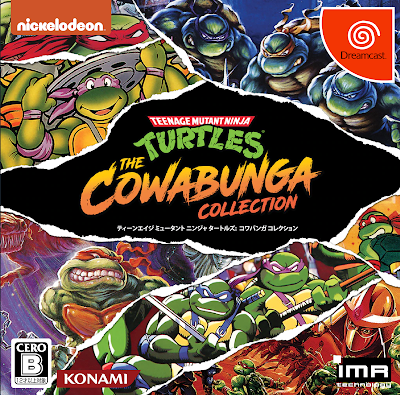We recently reported that Dreamcast coding legend Ian Micheal was working on a port of Teenage Mutant Ninja Turtles: The Cowabunga Collection for Sega's radical platform. We use the term 'port' very loosely though, because in light of the Dreamcast not getting an official release of The Cowabunga Collection, Ian has actually gone above and beyond and created what is essentially a definitive version of the compilation, arguably bettering what was officially released on current gen platforms by Digital Eclipse and Konami.
The result of five months of hard work, Teenage Mutant Ninja Turtles: The Cowabunga Collection for Dreamcast actually includes more content than the Konami release, and due to the 'indie' nature of the Dreamcast version, it also includes content that otherwise wouldn't be possible to include in an officially sanctioned port due to licensing issues.
 |
| The front end is marvellous! |
So with the Dreamcast version of The Cowabunga Collection probably being the definitive compilation of half-shell based retrogaming goodness, what exactly does it contain? In truth, an absolute treasure trove of perfectly emulated 8- and 16-bit TMNT titles from a range of classic systems (running at 60fps in some cases), episodes of TMNT cartoons digitised from VHS tapes, a Vanilla Ice music video (worth it for this alone in my opinion), scanned game manuals, full soundtracks for all games, VMU icons and logos, bespoke menus, display options...the list goes on.
 |
| Super NES emulation runs at 60fps. |
 |
| Vanilla Ice finally makes his Dreamcast debut. |
What's also quite interesting is that The Cowabunga Collection FAQ states that it will not run on an emulator - you'll need an actual Dreamcast to play it, so the fact that both GDEMU and burnable disc images are available is a bonus. Here's a full rundown of what you can expect in terms of playable titles included:
- Super Nintendo: Turtles IV: Turtles in Time (NTSC-U/PAL), Turtles Tournament Fighters (NTSC-U/PAL)
- Nintendo Entertainment System: Teenage Mutant Ninja Turtles (NTSC-U), Turtles II: The Arcade Game (NTSC-U), Turtles III: The Manhattan Project (NTSC-U), Turtles Tournament Fighters (NTSC-U)
- Nintendo Game Boy: Teenage Mutant Ninja Turtles: Fall of the Foot Clan (NTSC-U/PAL), Teenage Ninja Mutant Turtles II: Back from the Sewers (PAL), Teenage Mutant Ninja Turtles III: Radical Rescue (NTSC-U/PAL)
- Sega Mega Drive: Teenage Mutant Ninja Turtles: The Hyper Stone Heist (NTSC-U), Turtles Tournament Fighters (NTSC-U)
- Miscellaneous / ROM hacks: Teenage Mutant Ninja Turtles (ZX Spectrum), Teenage Mutant Ninja Turtles: The Coin-op! (ZX Spectrum), Teenage Mutant Ninja Turtles of Rage Remix (Mega Drive), Teenage Mutant Ninja Turtles of Rage: The Final Shell Shock (Mega Drive), Teenage Mutant Ninja Turtles: The Hyper Stone Heist Remixed (Dreamcast/Beats of Rage), Teenage Mutant Ninja Turtles: Lost in Space (Dreamcast/Beats of Rage)
As you can no doubt tell from this list of features and games, Teenage Mutant Ninja Turtles: The Cowabunga Collection for Dreamcast is easily one of the most impressive things to come out of the Dreamcast indie scene for quite some time, and huge props must go to Ian Micheal and artist Adam Burrell; and those from the wider Dreamcast community who supported the development process.
 |
| VMU artwork is a really nice touch! |
Teenage Mutant Ninja Turtles: The Cowabunga Collection for Dreamcast feels so polished it could be mistaken for an officially sanctioned title; and if it weren't for the fact that there are unlicensed roms included on this collection we dare say certain Dreamcast publishers would be snapping this up for a full physical retail release. It really is that good - from the menu music to the quality of life features (there's no need to soft reset the console to go back to the main menu...which is such a small thing, but so welcome!), everything about The Cowabunga Collection for Dreamcast just oozes quality.
There's also an intriguing 'first' included in The Cowabunga Collection, whereby FMV is layered over the top of other screens, creating a very nice visual effect (the main title screen is a good example of this). Believe it or not, this is a totally new tecnique created by Ian and has never been done in a Dreamcast game before. Nice.
 |
| It even features manual scans that are fully zoomable. |
 |
| Dreamcast BOR variants feature too. |
 |
| Really nice added features include game controls info screens. |
If you'd like to see the title screen effect, front end in motion, and also the quality of the various flavours of console emulation on display, check out Ian Micheal's video presentation below:
The Cowabunga Collection for Dreamcast is a real treat and the best bit is that it's totally free to download and enjoy yourself on real hardware. If you'd like to support Ian, you can find his Patreon page here...that said, I wouldn't be surprised if he gets snapped up by emulation specialists Digital Eclipse based on this interactive resume!
Head over to either the Dreamcast-Talk forums or Ian Micheal's radical YouTube channel for download links, which along with the game also include the lovely PAL and NTSC box art variants.
 |
| Be rude not to play Turtles games on the green Dreamcast! |
Have you sampled The Cowabunga Collection on Dreamcast? If so, let us know your thoughts on this bodacious release in the comments!
Update January 2023
After the initial release of The Cowabunga Collection for Dreamcast, it appears an updated version was posted to the internet. Named the 'Dark Theme Collection,' this slightly revised iteration also features the Streets of Rage 2 rom hack Shredder's Re-Revenge. Below is a thorough investigation into this updated version from YouTube channel Madlittlepixel:















































